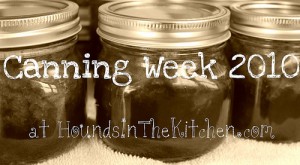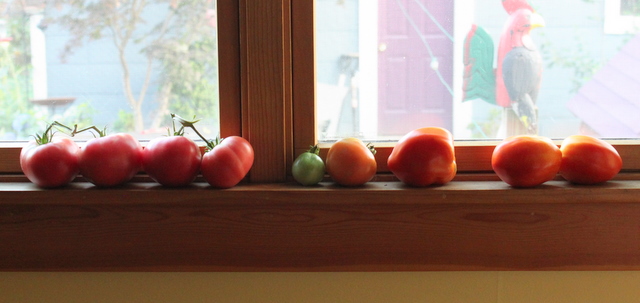 In Canning Week 2010 day 3, I share a bit about canning vegetables. View a lesson on pectin and recipe for peach jam from earlier in the week. Tomorrow I'll discuss pickles.
The massive harvests are starting, and they aren't limited to sweet fruits. Something has to be done with mountains of tomatoes, corn, green beans, and more.
In Canning Week 2010 day 3, I share a bit about canning vegetables. View a lesson on pectin and recipe for peach jam from earlier in the week. Tomorrow I'll discuss pickles.
The massive harvests are starting, and they aren't limited to sweet fruits. Something has to be done with mountains of tomatoes, corn, green beans, and more.
Canning is one useful option to preserve the harvest. Vegetables are a bit more tricky to can than fruits because they often contain less acid, so one has to rely on recipes.
Low acid vegetables must be canned in a pressure canning system. As I'm a bit afraid of my pressure cooker and I don't like the texture of most canned vegetables, I don't have experience pressure canning. There are recipes on Fresh Preserving to can fresh low acid vegetables including green beans, carrots, corn, and onions.
Tomatoes, high in acid, are commonly canned in a water bath. You can can them whole or in pieces. I prefer to can much of our harvest this way because it is most adaptable.
If you follow a recipe to maintain the correct acidity, you can also make and can pasta sauce, pizza sauce, barbecue sauce, ketchup, salsa or paste. We usually make a large batch of spaghetti sauce and several smaller batches of other tomato products throughout the late summer. I wrote about some of these options for the tomato tonnage last year.
I will be making a basic tomato sauce and canning it next Wednesday, August 11, from 6:30 - 8:30 at the North Market Dispatch Kitchen. For $12.99 ($8.99 for Slow Food Columbus members), participants will go home with a jar of sauce and confidence to preserve their own at home. Buy a ticket today and join me!
Basic Water Bath Canning Method
Use for tomato pieces, whole, or tomato-only sauce.
1. Blanche tomatoes by dipping whole tomatoes in boiling water for 1 minute and then immediately transferring to an ice water bath.
2. Remove skins from tomatoes. (Skip the blanching and removing skins if you don't mind them.)
3. Chop into desired pieces or use a food mill to make sauce.
4. Pack into sterilized jars.
5. Fill jars to exactly 1/2 inch of the top of the jar.
6. Use a thin knife or chopstick to gently release any air bubbles. Add a bit of extra tomato juice to top off the jar if necessary.
7. Add 1 teaspoon lemon juice per pint to adjust acidity and preserve color.
8. Top with sterilized lids and rings.
9. Place in boiling water bath for 40 minutes for pints, 45 minutes for quarts.
10. Remove from the water bath and allow to cool thoroughly before storing in a cool dark place.

